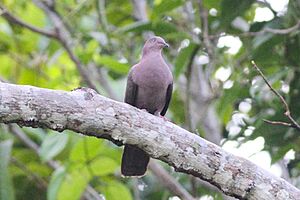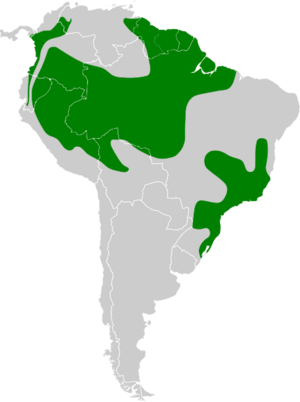Plumbeous pigeon facts for kids
Quick facts for kids Plumbeous pigeon |
|
|---|---|
 |
|
| Conservation status | |
| Scientific classification | |
| Genus: |
Patagioenas
|
| Species: |
plumbea
|
 |
|
| Synonyms | |
|
Columba plumbeaVieillot, 1818 |
|
The plumbeous pigeon (Patagioenas plumbea) is a cool type of bird that belongs to the Columbidae family, which includes all kinds of pigeons and doves. You can find this pigeon in many countries in Central and South America, like Bolivia, Brazil, Colombia, and Venezuela. It's known for its dark, lead-colored feathers, which is where it gets its name "plumbeous" from!
Contents
About This Pigeon's Family Tree
Scientists like to group living things based on how they are related. This is called taxonomy. The plumbeous pigeon is part of a group of pigeons called Patagioenas. It is very closely related to the ruddy pigeon, short-billed pigeon, and dusky pigeon.
Different Kinds of Plumbeous Pigeons
There are six different types, or subspecies, of the plumbeous pigeon. Each one has slight differences, often in their looks or where they live. These subspecies are:
- P. p. bogotensis
- P. p. chapmani
- P. p. pallescens
- P. p. wallacei
- P. p. baeri
- P. p. plumbea
Scientists are still studying if some of these subspecies might actually be different species because their calls sound so different!
What Does the Plumbeous Pigeon Look Like?
The plumbeous pigeon is about 34 centimeters (13 inches) long. It weighs between 172 and 231 grams (6.1 to 8.1 ounces).
Colors and Features
Male plumbeous pigeons have a dark gray head, neck, and belly. These parts sometimes have a pretty pink or purplish color. Their back, wings, and tail are a dark grayish-brown or dull olive green. The back of their neck might have shiny bronze spots. Their eyes are red and surrounded by bare, purplish-red skin.
Female pigeons look similar but have less intense purple colors. Their neck spots are often brighter than the males'. Young pigeons are duller than adults. They have very little purple and some feathers might have rusty edges.
How to Tell Them Apart
Different subspecies mostly vary in how much pink or purple they have. It can be tricky to tell the plumbeous pigeon apart from the ruddy pigeon if you see them in the same area. However, their calls are very different, which helps scientists and birdwatchers identify them.
Where Do Plumbeous Pigeons Live?
The plumbeous pigeon lives in many parts of Central and South America. Each subspecies lives in a specific region:
- P. p. chapmani lives on the west side of the Andes mountains, from Colombia down to Ecuador.
- P. p. bogotensis lives on the east side of the Andes, from Venezuela and Colombia down to Bolivia.
- P. p. wallacei is found in eastern Venezuela, the Guianas, and eastern parts of the Amazon in Brazil.
- P. p. pallescens lives in eastern Ecuador, eastern Peru, and western Brazil.
- P. p. baeri is found in Brazil, in the states of Goiás and Minas Gerais.
- P. p. plumbea lives in eastern Paraguay and southeastern Brazil.
Their Home Environment
These pigeons like to live in tropical and subtropical rainforests and cloudforests. They live in both old, untouched forests and forests that have grown back after being cut down. In some areas, they live high up in the mountains, while in others, they prefer lower elevations. In southeastern Brazil, they even move to different altitudes depending on the season.
Plumbeous Pigeon Behavior
Feeding Habits
The plumbeous pigeon looks for its food high up in the trees, in the forest canopy. They mostly eat fruit and seeds. In Brazil, they especially love to eat mistletoe fruits during certain times of the year.
Reproduction
Scientists do not know much yet about how plumbeous pigeons reproduce. More studies are needed to understand their breeding habits and life cycle.
Vocalizations (Songs and Calls)
The plumbeous pigeon's song is usually a repeated, rhythmic sound with 2 to 5 coos. Their call sounds like a purring, drawn-out "rrrrrow." There are at least five different groups of plumbeous pigeons that have slightly different songs, even though they follow the same general pattern.
Conservation Status
The IUCN (International Union for Conservation of Nature) has looked at the plumbeous pigeon's population. They have decided that this bird is of "Least Concern." This means that the species is widespread and quite common in its habitat, so it is not currently at risk of disappearing.


